34 Cam is a mechanical device that transforms rotary motion
34. Cam is a mechanical device that transforms rotary motion into linear motion. The shape of the disc is designed to produce a specified displacement pro- file. A displacement profile is a plot of the dis- placement of the follower as a function of the angle of rotation of the cam The motion of a cer- tain cam is given by the following equations: y 6120-0.5 sinej for 0s es y 6 for 1/2 se s21 /3 for 2R/3ses 6-3 1-0.5cos 3 6-2 3 for 4R/3 so s /2 for 31 /2s0s7R/4 1/4 for 71e KAS les 2T y 0.75 0.75 1 . Don\'t hesitate to send! - Recommended resolution is 1280 by 800 pixels. - Works only on MATLAB 7.4 (R2007a) and above. %} %% Main Figure and Menus figure(\'units\',\'normalized\',... \'position\',[.1 .1 .8 .75],... \'color\',\'w\',... \'numbertitle\',\'off\',... \'menubar\',\'none\',... \'name\',\'Cam Simulator\') m1=uimenu(\'Label\',\'File\'); m2=uimenu(\'Label\',\'More\'); % when you click on a menu the code go to its corresponding callback function uimenu(m1,\'Label\',\'Save Model\',\'Callback\',@savv); uimenu(m1,\'Label\',\'Load Model\',\'Callback\',@ladd,\'Separator\',\'on\'); uimenu(m1,\'Label\',\'Quit\',\'Callback\',@xq,\'Separator\',\'on\'); uimenu(m2,\'Label\',\'About\',\'Callback\',@bott); %% File -> quit function xq(varargin) close(gcf) end %% File -> Save function savv(varargin) % make a small figure with a button, text and edit figure(\'units\',\'normalized\',\'position\',[0.1 .6 .2 .2],\'color\',\'w\',\'numbertitle\',\'off\',\'menubar\',\'none\',\'name\',\'Save\') uicontrol(\'style\',\'text\',\'units\',\'normalized\',\'position\',[.05 .7 .9 .2],\'string\',\'Save Model As\',\'backgroundcolor\',\'w\',... \'fontsize\',15,\'fontweight\',\'b\',\'fontname\',\'arial\',\'horizontalalignment\',\'left\') se=uicontrol(\'style\',\'edit\',\'units\',\'normalized\',\'position\',[.05 .525 .7 .2],\'string\',\'\',\'backgroundcolor\',\'w\',... \'fontsize\',15,\'fontweight\',\'b\',\'fontname\',\'arial\',\'horizontalalignment\',\'left\'); uicontrol(\'style\',\'pushbutton\',\'units\',\'normalized\',\'position\',[.1 .25 .5 .2],\'string\',\'Save\',\'backgroundcolor\',\'w\',... \'fontsize\',15,\'fontweight\',\'b\',\'fontname\',\'arial\',\'horizontalalignment\',\'left\',\'callback\',@savvy) % what happens when you press \'Save\' function savvy(varargin) ns=get(se,\'string\'); % get name in edit box close(gcf) % close the \'Save\' figure window % get important values from edit boxes Types=get(MT,\'string\');%#ok Disps=(get(MA,\'string\'));%#ok Durations=(get(MD,\'string\'));%#ok rb=(get(BC,\'string\'));%#ok if get(hr,\'selectedobject\')==hb1 % flat face follower has less variables to save ;) %this variable is to indicate how many variables are saved. it %will be used when we load kk=1; %#ok % save needed variables in the name in the directory Models\\ save([\'Models\\\',ns,\'.mat\'],\'Types\',\'Disps\',\'Durations\',\'rb\',\'kk\') else kk=2; %#ok rd=(get(t2,\'string\')); %#ok e=(get(t4,\'string\')); %#ok kc=(get(t6,\'string\')); %#ok save([\'Models\\\',ns,\'.mat\'],\'Types\',\'Disps\' ,\'Durations\' ,\'rb\',\'rd\',\'e\',\'kc\',\'kk\') end end end %% File -> Load function ladd(varargin) % make a small figure window with a button, edit and text figure(\'units\',\'normalized\',\'position\',[0.1 .6 .4 .2],\'color\',\'w\',\'numbertitle\',\'off\',\'menubar\',\'none\',\'name\',\'Load\') uicontrol(\'style\',\'text\',\'units\',\'normalized\',\'position\',[.05 .7 .9/2 .2],\'string\',\'Enter Name of Model\',\'backgroundcolor\',\'w\',... \'fontsize\',11,\'fontweight\',\'b\',\'fontname\',\'arial\',\'horizontalalignment\',\'left\') uicontrol(\'style\',\'text\',\'units\',\'normalized\',\'position\',[.05+.9/2+.1-.1 .7 .9/2 .2],\'string\',\'Available Models\',\'backgroundcolor\',\'w\',... \'fontsize\',11,\'fontweight\',\'b\',\'fontname\',\'arial\',\'horizontalalignment\',\'left\') se=uicontrol(\'style\',\'edit\',\'units\',\'normalized\',\'position\',[.05 .525 .7/2 .2],\'string\',\'\',\'backgroundcolor\',\'w\',... \'fontsize\',15,\'fontweight\',\'b\',\'fontname\',\'arial\',\'horizontalalignment\',\'left\'); uicontrol(\'style\',\'pushbutton\',\'units\',\'normalized\',\'position\',[.1 .25 .5/2 .2],\'string\',\'Load\',\'backgroundcolor\',\'w\',... \'fontsize\',15,\'fontweight\',\'b\',\'fontname\',\'arial\',\'horizontalalignment\',\'left\',\'callback\',@laddy) % get all files in the folder \'Models\' that end with \'.mat\' pW=dir(\'Models\\*.mat\'); % save their names as a character matrix hol=strvcat(pW.name); % change \'.mat\' into spaces for each name for lopp=1:size(hol,1) hol(lopp,:)=strrep(hol(lopp,:),\'.mat\',repmat(\' \',1,4)); end % make a listbox with the previous names matrix as string pl=uicontrol(\'style\',\'listbox\',\'max\',2,\'units\',\'normalized\',\'position\',[.05+.9/2 .1 .9/2 .7],\'string\',hol,\'backgroundcolor\',\'w\',... \'fontsize\',11,\'fontweight\',\'b\',\'fontname\',\'arial\',\'horizontalalignment\',\'left\',\'callback\',@yah); % every time you click a name in the listbox the name is displayed in % the edit box as per the following function function yah(varargin) sh=get(pl,\'value\'); % get value of chosen element in the listbox sg=(get(pl,\'string\')); sj=sg(sh,:); % get the string respective to that value set(se,\'string\',sj) % put said string in edit box end % what happens when you press the \'Load\' button in the Load figure window function laddy(varargin) ns=get(se,\'string\'); % get the name in the edit box ns(ns==\' \')=[]; % delete spaces that strvcat produced at the end of names close(gcf) % close the Load figure window % load the variable kk from name (used to see how many variables are to % be loaded, since flat face follower has less characteristics to load) load([\'Models\\\',ns,\'.mat\'],\'kk\') if kk==1 % flat face follower % select flat face radio button set(hr,\'selectedobject\',hb1) % load variables from Models\\\'filename\' load([\'Models\\\',ns,\'.mat\'],\'Types\',\'Disps\' ,\'Durations\' ,\'rb\') % set edit boxes as per loaded variables set(MT,\'string\',Types) set(MA,\'string\',Disps) set(MD,\'string\',Durations) set(BC,\'string\',rb) else % same as before, but roller follower has more variables to be loaded set(hr,\'selectedobject\',hb2) load([\'Models\\\',ns,\'.mat\'],\'Types\',\'Disps\' ,\'Durations\' ,\'rb\',\'rd\',\'e\',\'kc\') set(MT,\'string\',Types) set(MA,\'string\',Disps) set(MD,\'string\',Durations) set(BC,\'string\',rb) set(t2,\'string\',rd) set(t4,\'string\',e) set(t6,\'string\',kc) end CGMT % go to the function of changing follower type (to set some things visible on/off) end end %% More -> About function bott(varargin) figure(\'units\',\'normalized\',\'position\',[0.1 .7 .25 .1],\'color\',\'w\',\'numbertitle\',\'off\',\'menubar\',\'none\',\'name\',\'About\'); uicontrol(\'style\',\'text\',\'units\',\'normalized\',\'position\',[.05 .25 .6 .2],\'string\',\'numandina@gmail.com\',\'backgroundcolor\',\'w\',... \'fontsize\',11,\'fontweight\',\'b\',\'fontname\',\'arial\',\'horizontalalignment\',\'left\'); uicontrol(\'style\',\'text\',\'units\',\'normalized\',\'position\',[.05 .65 .6 .2],\'string\',\'Husam Aldahiyat 28/12/2008\',\'backgroundcolor\',\'w\',... \'fontsize\',11,\'fontweight\',\'b\',\'fontname\',\'arial\',\'horizontalalignment\',\'left\'); end %% Main Figure uicontrols (edits, text, etc...) % some texts uicontrol(\'style\',\'text\',\'units\',\'normalized\',\'position\',[.025 .9 .08 .05],\'backgroundcolor\',\'w\',\'max\',2,... \'fontsize\',12,\'fontname\',\'calibri\',\'string\',\'Motion Type\') uicontrol(\'style\',\'text\',\'units\',\'normalized\',\'position\',[.125 .9 .08 .075],\'backgroundcolor\',\'w\',\'max\',2,... \'fontsize\',12,\'fontname\',\'calibri\',\'string\',\'Motion Duration\') uicontrol(\'style\',\'text\',\'units\',\'normalized\',\'position\',[.225 .875 .085 .075],\'backgroundcolor\',\'w\',\'max\',2,... \'fontsize\',11,\'fontname\',\'calibri\',\'string\',\'Displacement\') % this is the black axis that acts as a seperator axes(\'position\',[.35 0 .025 1],\'color\',\'k\',\'xcolor\',\'w\',\'ycolor\',\'w\',\'zcolor\',\'w\',\'xtick\',100,\'ytick\',100) % the little squares above \'Res\'. they act as a loading bar hl(1)=uicontrol(\'style\',\'text\',\'units\',\'normalized\',\'position\',[.335 .95 .005 .0075],\'backgroundcolor\',\'r\'); hl(2)=uicontrol(\'style\',\'text\',\'units\',\'normalized\',\'position\',[.335 .94 .005 .0075],\'backgroundcolor\',\'r\'); hl(3)=uicontrol(\'style\',\'text\',\'units\',\'normalized\',\'position\',[.335 .93 .005 .0075],\'backgroundcolor\',\'r\'); hl(4)=uicontrol(\'style\',\'text\',\'units\',\'normalized\',\'position\',[.335 .92 .005 .0075],\'backgroundcolor\',\'r\'); hl(5)=uicontrol(\'style\',\'text\',\'units\',\'normalized\',\'position\',[.335 .91 .005 .0075],\'backgroundcolor\',\'r\'); hl(6)=uicontrol(\'style\',\'text\',\'units\',\'normalized\',\'position\',[.335 .9 .005 .0075],\'backgroundcolor\',\'r\'); hl(7)=uicontrol(\'style\',\'text\',\'units\',\'normalized\',\'position\',[.335 .89 .005 .0075],\'backgroundcolor\',\'r\'); hl(8)=uicontrol(\'style\',\'text\',\'units\',\'normalized\',\'position\',[.335 .88 .005 .0075],\'backgroundcolor\',\'r\'); hl(9)=uicontrol(\'style\',\'text\',\'units\',\'normalized\',\'position\',[.335 .87 .005 .0075],\'backgroundcolor\',\'r\'); hl(10)=uicontrol(\'style\',\'text\',\'units\',\'normalized\',\'position\',[.335 .86 .005 .0075],\'backgroundcolor\',\'r\'); % dummy text, used only to store certain values so that they would be retrieved % later by another function dummy1=uicontrol(\'style\',\'text\',\'visible\',\'off\',\'max\',2); dummy2=uicontrol(\'style\',\'text\',\'visible\',\'off\',\'max\',2); dummy3=uicontrol(\'style\',\'text\',\'visible\',\'off\',\'max\',2); % some more stuff uicontrol(\'style\',\'text\',\'units\',\'normalized\',\'position\',[.31 .82 .035 .025],\'string\',\'Res\',\'backgroundcolor\',\'w\'); rR=uicontrol(\'style\',\'edit\',\'units\',\'normalized\',\'position\',[.31 .79 .035 .025],\'string\',\'100\',\'backgroundcolor\',\'w\'); MT=uicontrol(\'style\',\'edit\',\'units\',\'normalized\',\'position\',[.025 .6 .08 .3],\'backgroundcolor\',\'w\',\'max\',2,... \'fontsize\',14,\'fontname\',\'calibri\'); MD=uicontrol(\'style\',\'edit\',\'units\',\'normalized\',\'position\',[.125 .6 .08 .3],\'backgroundcolor\',\'w\',\'max\',2,... \'fontsize\',14,\'fontname\',\'calibri\'); MA=uicontrol(\'style\',\'edit\',\'units\',\'normalized\',\'position\',[.225 .6 .08 .3],\'backgroundcolor\',\'w\',\'max\',2,... \'fontsize\',14,\'fontname\',\'calibri\'); uicontrol(\'style\',\'text\',\'units\',\'normalized\',\'position\',[.025 .5 .2 .05],\'backgroundcolor\',\'w\',... \'fontsize\',12,\'fontname\',\'calibri\',\'string\',\'SHM: Simple Harmonic Motion\',\'horizontalalignment\',\'left\'); uicontrol(\'style\',\'text\',\'units\',\'normalized\',\'position\',[.025 .45 .3 .05],\'backgroundcolor\',\'w\',... \'fontsize\',12,\'fontname\',\'calibri\',\'string\',\'DWL: Dwell CSV: Constant Velocity\',\'horizontalalignment\',\'left\'); uicontrol(\'style\',\'text\',\'units\',\'normalized\',\'position\',[.025 .4 .2 .05],\'backgroundcolor\',\'w\',... \'fontsize\',12,\'fontname\',\'calibri\',\'string\',\'PAR: Parabolic Motion\',\'horizontalalignment\',\'left\'); uicontrol(\'style\',\'text\',\'units\',\'normalized\',\'position\',[.025 .35 .2 .05],\'backgroundcolor\',\'w\',... \'fontsize\',12,\'fontname\',\'calibri\',\'string\',\'CYC: Cycloidal Motion\',\'horizontalalignment\',\'left\'); uicontrol(\'style\',\'text\',\'units\',\'normalized\',\'position\',[.025 .3 .15 .05],\'backgroundcolor\',\'w\',... \'fontsize\',10,\'fontname\',\'calibri\',\'string\',\'Base Circle Radius: \',\'horizontalalignment\',\'left\'); BC=uicontrol(\'style\',\'edit\',\'units\',\'normalized\',\'position\',[.145 .32 .03 .035],\'backgroundcolor\',\'w\',... \'fontsize\',10,\'fontname\',\'calibri\',\'string\',\' \',\'horizontalalignment\',\'center\'); % \'Go\' pushbutton BB=uicontrol(\'style\',\'pushbutton\',\'units\',\'normalized\',\'position\',[.225 .025 .08 .05],\'backgroundcolor\',\'w\',... \'fontsize\',14,\'fontname\',\'calibri\',\'string\',\'Go\',\'callback\',@go); D3=uicontrol(\'style\',\'pushbutton\',\'units\',\'normalized\',\'position\',[.225 .4 .08 .05],\'backgroundcolor\',\'w\',... \'fontsize\',14,\'fontname\',\'calibri\',\'string\',\'3D\',\'callback\',@go3,\'visible\',\'off\'); % choose follower type radio group hr=uibuttongroup(\'Units\',\'normalized\',... \'Position\',[.025 .25 .3 .05],\'SelectionChangeFcn\',@CGMT); hb1=uicontrol(\'Style\',\'Radiobutton\',\'String\',\'Flat Face Follower\',\'Units\',\'normalized\',... \'Position\',[0 0 1/2 1],\'Parent\',hr,\'backgroundcolor\',[1 1 1],\'foregroundcolor\',[0 0 0]); hb2=uicontrol(\'Style\',\'Radiobutton\',\'String\',\'Translating Roller Follower\',\'Units\',\'normalized\',... \'Position\',[1/2 0 1/2 1],\'Parent\',hr,\'backgroundcolor\',[1 1 1],\'foregroundcolor\',[0 0 0]); % speed of animation radio group hr2=uibuttongroup(\'Units\',\'normalized\',... \'Position\',[.175 .1 .15 .05]); hbs=uicontrol(\'Style\',\'Radiobutton\',\'String\',\'Fast\',\'Units\',\'normalized\',... \'Position\',[0 0 1/3 1],\'Parent\',hr2,\'backgroundcolor\',[1 1 1],\'foregroundcolor\',[0 0 0]); hbk=uicontrol(\'Style\',\'Radiobutton\',\'String\',\'Slow\',\'Units\',\'normalized\',... \'Position\',[1/3 0 1/3 1],\'Parent\',hr2,\'backgroundcolor\',[1 1 1],\'foregroundcolor\',[0 0 0]); uicontrol(\'Style\',\'Radiobutton\',\'String\',\'Pause\',\'Units\',\'normalized\',... \'Position\',[2/3 0 1/3 1],\'Parent\',hr2,\'backgroundcolor\',[1 1 1],\'foregroundcolor\',[0 0 0]); % texts that are set on/off depending on follower type t1=uicontrol(\'style\',\'text\',\'units\',\'normalized\',\'position\',[.025 .18 .15 .05],\'backgroundcolor\',\'w\',... \'fontsize\',10,\'fontname\',\'calibri\',\'string\',\'Roller Radius: \',\'horizontalalignment\',\'left\'); t2=uicontrol(\'style\',\'edit\',\'units\',\'normalized\',\'position\',[.125 .2 .03 .035],\'backgroundcolor\',\'w\',... \'fontsize\',10,\'fontname\',\'calibri\',\'string\',\' \',\'horizontalalignment\',\'center\'); t3=uicontrol(\'style\',\'text\',\'units\',\'normalized\',\'position\',[.025 .14 .15 .05],\'backgroundcolor\',\'w\',... \'fontsize\',10,\'fontname\',\'calibri\',\'string\',\'Offset: \',\'horizontalalignment\',\'left\'); t4=uicontrol(\'style\',\'edit\',\'units\',\'normalized\',\'position\',[.125 .16 .03 .035],\'backgroundcolor\',\'w\',... \'fontsize\',10,\'fontname\',\'calibri\',\'string\',\' \',\'horizontalalignment\',\'center\'); t5=uicontrol(\'style\',\'text\',\'units\',\'normalized\',\'position\',[.025 .1 .15 .05],\'backgroundcolor\',\'w\',... \'fontsize\',10,\'fontname\',\'calibri\',\'string\',\'Inside/Ouside(~): \',\'horizontalalignment\',\'left\'); t6=uicontrol(\'style\',\'edit\',\'units\',\'normalized\',\'position\',[.125 .12 .03 .035],\'backgroundcolor\',\'w\',... \'fontsize\',10,\'fontname\',\'calibri\',\'string\',\'0\',\'horizontalalignment\',\'center\'); % text and edits at the lower left corner of the main figure window uicontrol(\'style\',\'text\',\'units\',\'normalized\',\'position\',[.025 .065 .15 .05],\'backgroundcolor\',\'w\',... \'fontsize\',10,\'fontname\',\'calibri\',\'string\',\'Axis Limits: \',\'horizontalalignment\',\'left\'); uicontrol(\'style\',\'text\',\'units\',\'normalized\',\'position\',[.025 -.005 .15 .05],\'backgroundcolor\',\'w\',... \'fontsize\',10,\'fontname\',\'calibri\',\'string\',\'[y1 y2]\',\'horizontalalignment\',\'left\',\'fontweight\',\'b\'); uicontrol(\'style\',\'edit\',\'units\',\'normalized\',\'position\',[.025 .05 .05 .035],\'backgroundcolor\',\'w\',... \'fontsize\',10,\'fontname\',\'calibri\',\'string\',\'\',\'horizontalalignment\',\'center\',\'callback\',@ca1,\'enable\',\'off\'); al2=uicontrol(\'style\',\'edit\',\'units\',\'normalized\',\'position\',[.08 .05 .05 .035],\'backgroundcolor\',\'w\',... \'fontsize\',10,\'fontname\',\'calibri\',\'string\',\'\',\'horizontalalignment\',\'center\',\'callback\',@ca2); al3=uicontrol(\'style\',\'edit\',\'units\',\'normalized\',\'position\',[.13 .05 .05 .035],\'backgroundcolor\',\'w\',... \'fontsize\',10,\'fontname\',\'calibri\',\'string\',\'\',\'horizontalalignment\',\'center\',\'callback\',@ca3); % create the four axes and hide them for now a1=axes(\'position\',[.4 .65 .55/3 .3]); % Displacement a2=axes(\'position\',[.4+.55/3+.025 .65 .55/3 .3]); % Velocity a3=axes(\'position\',[.4+.55/3*2+.05 .65 .55/3 .3]); % Acceleration a4=axes(\'position\',[.4 .025 .55 .55]); % cam profile axes set(findobj(\'type\',\'axes\',\'-not\',\'color\',\'k\'),\'visible\',\'off\') % hide them % evaluate this function which sets certain uicontrols\' visiblity on/off CGMT %% Change Axis Limits function ca2(varargin) an1=str2num(get(al2,\'string\')); %#ok % get limits from edit box set(a2,\'ylim\',an1(1:2)); % set these limits for the corresponding axes end function ca3(varargin) an1=str2num(get(al3,\'string\')); %#ok set(a3,\'ylim\',an1(1:2)); end %{ function ca1(varargin) an1=str2num(get(al1,\'string\')); set(a1,\'ylim\',an1(1:2)); end %} %% Change Follower Type function CGMT(varargin) if get(hr,\'selectedobject\')==hb1 % flat face set(t1,\'visible\',\'off\') % rf text set(t2,\'visible\',\'off\') % rf edit set(t3,\'visible\',\'off\') % offset text set(t4,\'visible\',\'off\') % offset edit set(t5,\'visible\',\'off\') % inside/outside text set(t6,\'visible\',\'off\') % inside/outside edit else set(t1,\'visible\',\'on\') set(t2,\'visible\',\'on\') set(t3,\'visible\',\'on\') set(t4,\'visible\',\'on\') set(t5,\'visible\',\'on\') set(t6,\'visible\',\'on\') end end %% Motion Program Functions % Dwell function [s,si,ti]=DWL(si,ti,a) s=sym(si); % create motion equation ezplot(s,[ti,ti+a]) % plot motion equation ti=ti+a; end % Simple Harmonic Motion function [s,si,ti]=SHM(si,ti,h,a) s=si+h/2*(1-cos(pi/a*(sym(\'x\')-ti))); si=subs(s,a+ti); ezplot(s,[ti,ti+a]) ti=ti+a; end % Parabolic Motion function [s1,s2,si,ti]=PAR(si,ti,h,a) s1=si+2*h/a^2*(sym(\'x\')-ti)^2; s2=si+h*(-1+4*(sym(\'x\')-ti)/a-2*(sym(\'x\')-ti)^2/a^2); si=subs(s2,ti+a); ezplot(s1,[ti,ti+a/2]) hold on ezplot(s2,[ti+a/2,ti+a]) xlim([ti ti+a]) ti=ti+a; end % Cycloidal Motion function [s,si,ti]=CYC(si,ti,h,a) s=si+h*((sym(\'x\')-ti)/a-1/2/pi*sin(2*pi*(sym(\'x\')-ti)/a)); si=subs(s,ti+a); ezplot(s,[ti,ti+a]) ti=ti+a; end % Constant Velocity function [s,si,ti]=CV(si,ti,h,a) s=si+h/a*((sym(\'x\')-ti)); si=subs(s,ti+a); ezplot(s,[ti,ti+a]) ti=ti+a; end %% The \'Go\' Button function go(varargin) % make 3D button disappear until after loading set(D3,\'visible\',\'off\') % if the button\'s string is \'stop\', do just that if strcmp(get(BB,\'string\'),\'Stop\') set(BB,\'string\',\'Go\') if get(hr,\'selectedobject\')==hb1 % flat face chosen set(D3,\'visible\',\'on\') % make 3D button appear end return end % reset all loading \'blocks\' to red colour set(hl,\'backgroundcolor\',\'r\') % get values for the three main edit boxes Types=get(MT,\'string\'); Disps=[str2num(get(MA,\'string\'));0];%#ok Durations=str2num(get(MD,\'string\')).*pi/180;%#ok % reveal axes set(findobj(\'type\',\'axes\'),\'visible\',\'on\') si=0; % initial displacement is zero ti=0; % initial theta is zero S=[]; % motion equation(s) matrix T=ti; % theta timeline-esque vector % set displacement axes as current one (i.e. all subsequent plots will % be done on it) axes(a1) cla hold on %% Displacement Diagram % the following loop obtains for us the motion equation(s) for the % follower as well as plots the displacement diagram for lp1=1:length(Durations) % go through loop once for every motion type entered pp=ti; % variable used for parabolic motion switch Types(lp1,:) case \'DWL\' [s,si,ti]=DWL(si,ti,Durations(lp1)); S=[S;s]; % stack latest motion equation T=[T;ti]; % put latest theta in theta timeline case \'SHM\' [s,si,ti]=SHM(si,ti,Disps(lp1),Durations(lp1)); S=[S;s]; T=[T;ti]; case \'PAR\' [s1,s2,si,ti]=PAR(si,ti,Disps(lp1),Durations(lp1)); S=[S;s1;s2]; T=[T;(ti+pp)/2;ti]; case \'CYC\' [s,si,ti]=CYC(si,ti,Disps(lp1),Durations(lp1)); S=[S;s]; T=[T;ti]; case \'CSV\' [s,si,ti]=CV(si,ti,Disps(lp1),Durations(lp1)); S=[S;s]; T=[T;ti]; end end JJ=zeros(length(S),1); %Preallocate to save time! for klp=1:length(S) % get displacements of follower at each of the critical values of theta JJ(klp)=subs(S(klp),T(klp+1)); end % using previous JJ vector set axis limits for displacement diagram axis([0 ti min(JJ)-(max(JJ)-min(JJ))/10-1e-9 max(JJ)+(max(JJ)-min(JJ))/10+1e-9]) title(\'Displacement\') xlabel(\'Radians\') %% Velocity Diagram axes(a2) cla hold on % velocity is the derivative of displacement ;) S1=diff(S); % plot each velocity equation for its equivalent theta range for lp1=1:length(S1) ezplot(S1(lp1),[T(lp1) T(lp1+1)]); end xlim([0 ti]) title(\'Velocity\') xlabel(\'\') %% Acceleration Diagram axes(a3) cla hold on % derivate velocity to obtain acceleration S2=diff(S1); % plot resultant equations for their matching theta ranges for lp1=1:length(S) ezplot(S2(lp1),[T(lp1) T(lp1+1)]); end xlim([0 ti]) title(\'Acceleration\') xlabel(\'Radians\') drawnow() % give user something to look at while he waits for the rest of the % computations %% Cam Profile reR=str2double(get(rR,\'string\')); % get number of points used to plot x=zeros(1,reR+1); % x points of profile y=zeros(1,reR+1); % y points of profile pa=zeros(1,reR+1); % pressure angles. there is a different pressure angle for each theta, % where it is the angle between the vertical line of motion and the normal % to the tangent of the two contact surfaces rb=str2double(get(BC,\'string\')); % get base circle radius cc=0; % counter QM=10; % used for loading blocks if get(hr,\'selectedobject\')==hb1 % flat face chosen who=1; e=0; rd=0; beta=0; else % translating roller follower who=0; rd=str2double(get(t2,\'string\')); % roller radius e=str2double(get(t4,\'string\')); % roller offset beta=asin(e/sum([rb,rd])); end % change theta from zeros to 360 degrees for k=0:2*pi/reR:2*pi % increment counter cc=cc+1; % obtain where the current angle is in terms of theta timeline % (i.e. get in which range of angles it is) for p=1:length(T)-1 if k<=T(p+1) a=p; break end end % every time theta is increased 10% of the 2*pi radians, change a % loading block\'s colour to green if (k/2/pi*100)>QM set(hl(QM/10),\'backgroundcolor\',\'g\') drawnow() QM=QM+10; end % equations for the cam profile. % remember: % - different followers call for different equations and profiles % - we need s and s\', which can be obtained by substituting our % angle into its matching motion equation and velocity equation if get(hr,\'selectedobject\')==hb1 % flat face follower x(cc)=-(rb+subs(S(a),k))*sin(k)-subs(S1(a),k)*cos(k); y(cc)=(rb+subs(S(a),k))*cos(k)-subs(S1(a),k)*sin(k); else % translating roller follower if strcmp(get(t6,\'string\'),\'1\') % inside koin=-1; else % outside koin=1; end % can be found in your machinery textbook xc=-(rb+rd)*sin(k+beta)-subs(S(a),k)*sin(k); yc=(rb+rd)*cos(k+beta)+subs(S(a),k)*cos(k); dxc=-(rb+rd)*cos(k+beta)-subs(S(a),k)*cos(k)-subs(S1(a),k)*sin(k); dyc=-(rb+rd)*sin(k+beta)-subs(S(a),k)*sin(k)+subs(S1(a),k)*cos(k); x(cc)=xc-koin*rd*dyc*(dxc^2+dyc^2)^-.5; y(cc)=yc+koin*rd*dxc*(dxc^2+dyc^2)^-.5; pa(cc)=atan(((subs(S1(a),k))-e)/(subs(S(a),k)+sqrt((rb+rd)^2-e^2))); end end % just to make sure, set all loading block colours to green set(hl,\'backgroundcolor\',\'g\') % set push button string to \'Stop\', since soon we\'ll be animating set(BB,\'string\',\'Stop\') % store x and y vectors in dummy texts set(dummy1,\'string\',mat2str(x)) set(dummy2,\'string\',mat2str(y)) set(dummy3,\'string\',mat2str(T)) % send a bunch of information to the cam animation function Untitled6(x,y,S,T,a4,a1,rb,max(JJ),BB,who,beta,e,rd,pa,reR) end %% Cam Animation % We\'ll be concerned with rotating the cam around and round in clockwise % rotation. the following function will do that function Untitled6(x,y,S,T,fi2,agl,rb,last,BB,who,beta,varargin) reR=varargin{4}; % number of points pA=varargin{3}; % pressure angles vector axes(fi2) % big axes cla hold on % h=plot(x,y); % plot the cam profile and fill it in grey h=fill(x,y,[.5 .5 .5]); set(h,\'linewidth\',2) % plot the base circle, just for reference circle([0 0],rb,reR,\'c--\') plot(0,0,\'c.\') % thicken the digrams and soon to be drawn follower set(findobj(\'type\',\'line\',\'color\',\'b\'),\'linewidth\',2) % set appropriate axis limits axis([min(x)-(max(x)-min(x))/2-varargin{2} max(x)+(max(x)-min(x))/2+varargin{2} min(y)-(max(y)-min(y))/2-varargin{2} last+rb+(max(y)-min(y))/2+varargin{2}]) axis equal p2=0; % initially, cam is rotated 0 degrees % the following is the rotation loop while strcmp((get(BB,\'string\')),\'Stop\') % keep rotating until the user presses the \'Stop\' button % change speed radio buttons if get(hr2,\'selectedobject\')==hbs % fast fsf=10; % rotate by 10 degrees each time elseif get(hr2,\'selectedobject\')==hbk % slow fsf=1; else % pause fsf=0; end rotate(h,[0 0 1],-fsf,[0 0 1]) % rotate cam around centre of base circle % p2 gives us how many radians the cam has already rotated p2=p2+fsf/180*pi; if p2>2*pi p2=p2-2*pi; end % next comes the follower motion % get in what range of angles theta lies for p=1:length(T)-1 if p2<=T(p+1) a=p; break end end % then substitute our angle in its consequent motion equations ch=subs(S(a),p2)+rb; % this value gives us the y location of our follower if who % flat face follower ppp=line([min(x)+(max(x)-min(x))/4,max(x)-(max(x)-min(x))/4],[ch ch]); else % the follower circle, varargin{1} is the horizontal offest (e) ppp=circle([-varargin{1} ch+(rb+varargin{2})*cos(beta)-rb],varargin{2},100); % line representing the line of motion lll=line([-varargin{1} -varargin{1}],[0 rb*2+ch]); set(lll,\'linestyle\',\'-\',\'color\',\'r\') % get pressure angle for current theta pa=interp1(0:2*pi/reR:2*pi,pA,p2); % draw line that represents the pressure line ooo=line([-varargin{1}-2*sin(pa) -varargin{1}+(2*varargin{2}+2)*sin(pa)],... [ch+(rb+varargin{2})*cos(beta)-rb-2*cos(pa) (ch+(rb+varargin{2})*cos(beta)-rb)+(2+2*(varargin{2}))*cos(pa)]); set(ooo,\'linestyle\',\'-\',\'color\',\'r\') title([\'\\phi = \',num2str(pa/pi*180,3)]) end if exist(\'hag\',\'var\') delete(hag) end hag=ang([0 0],rb/2,[0 -p2],\'w.\'); % draw an arc from 0 to theta degrees set(ppp,\'linewidth\',3,\'color\',\'b\') % show follower displacement on the motion diagram from before axes(agl) delete(findobj(\'marker\',\'*\')) plot(p2,ch-rb,\'m*\') % show current position on the axes drawnow() % return to our cam profile axes and tidy it up axes(fi2) axis([min(x)-(max(x)-min(x))/2-varargin{2} max(x)+(max(x)-min(x))/2+varargin{2} min(y)-(max(y)-min(y))/2-varargin{2} last+rb+(max(y)-min(y))/2+varargin{2}]) pause(.001) % duration between our \'frames\' delete(ppp) if ~who delete(lll) delete(ooo) end end end %% \'3D\' Button function go3(varargin) x=str2num(get(dummy1,\'string\')); %#ok y=str2num(get(dummy2,\'string\')); %#ok T=str2num(get(dummy3,\'string\')); %#ok rb=str2double(get(BC,\'string\')); if get(hr,\'selectedobject\')==hb1 e=0; hok=1; rd=0; else e=str2double(get(t4,\'string\')); hok=0; rd=str2double(get(t2,\'string\')); end Durations=str2num(get(MD,\'string\')).*pi/180; %#ok Disps=[str2num(get(MA,\'string\'));1e-9;-1e-9];%#ok z1=sum(-abs(Disps)); z2=sum(abs(Disps)); dg(x,y,S,T,e,rb,z1,z2,hok,rd) end end %% Angle Function % function that draws an arc based on it centre, radius and angle span. % burrows from the function CIRCLE function h = ang(centre,radius,span,style) theta = linspace(span(1),span(2),100); rho = ones(1,100) * radius; [x,y] = pol2cart(theta,rho); x = x + centre(1); y = y + centre(2); x=x(end); y=y(end); h = plot(x,y,style); end %% Circle Function % function that draws a circle based on its centre and radius. I didn\'t make it; % it was created by Zhenhai Wang on the MATLAB File Exchange function H=circle(center,radius,NOP,style) if (nargin==3) style=\'b-\'; end THETA=linspace(0,2*pi,NOP); RHO=ones(1,NOP)*radius; [X,Y] = pol2cart(THETA,RHO); X=X+center(1); Y=Y+center(2); H=plot(X,Y,style); axis square end %% 3D Animation function dg(x,y,S,T,e,rb,z1,z3,hok,rd) S T figure hold on set(gcf,\'color\',\'w\',\'numbertitle\',\'off\',\'menubar\',\'none\',\'name\',\'3D (Demo)\') set(gca,\'xcolor\',\'w\',\'ycolor\',\'w\',\'zcolor\',\'w\') z=zeros(size(x)); z2=ones(size(x)); view(3) f1=fill3(x,z,y,[.5 .5 .5],\'edgecolor\',[.7 .7 .7],\'FaceVertexAlphaData\',0.9,\'FaceAlpha\',\'flat\'); f2=fill3(x,z2,y,[.5 .5 .5],\'edgecolor\',[.5 .5 .5]); % [gg,hh,jj]=cylinder(repmat(rb,1,100)); % jj=[-flipud(jj);jj]; % jj=jj*6; % for p=1:size(jj,1)/2 % jj(p,:)=[]; % end % hhh=surf(gg,jj,hh); kk=[f1;f2]; p2=0; while true rotate(kk,[0 1 0],5,[0 1 0]) p2=p2+5/180*pi; if p2>2*pi p2=p2-2*pi; end axis([(z1-rb) z3+rb -5 5 z1 z3].*2) for p=1:length(T)-1 if p2<=T(p+1) a=p; break end end ch=subs(S(a),p2)+rb; if hok a=[min(x)+(max(x)-min(x))/4 0 0; max(x)-(max(x)-min(x))/4 0 0; max(x)-(max(x)-min(x))/4 1 0; min(x)+(max(x)-min(x))/4 1 0; min(x)+(max(x)-min(x))/4 0 z3/2; max(x)-(max(x)-min(x))/4 0 z3/2; max(x)-(max(x)-min(x))/4 1 z3/2; min(x)+(max(x)-min(x))/4 1 z3/2]; else a=[0 0 0; 1 0 0; 1 1 0; 0 1 0; 0 0 z3/2; 1 0 z3/2; 1 1 z3/2; 0 1 z3/2]; a(:,1)=a(:,1)*.3; end a(:,1)=a(:,1)+e; a(:,2)=a(:,2)*.3; a(:,3)=a(:,3)+(ch)+rd; b=[1 2 6 5;2 3 7 6;3 4 8 7;4 1 5 8;1 2 3 4;5 6 7 8]; ppp=patch(\'vertices\',a,\'faces\',b,\'edgecolor\',\'r\',\'facecolor\',\'k\',\'linewidth\',2,\'FaceVertexAlphaData\',0.5); rotate3d on pause(.001) delete(ppp) end end %% EOF
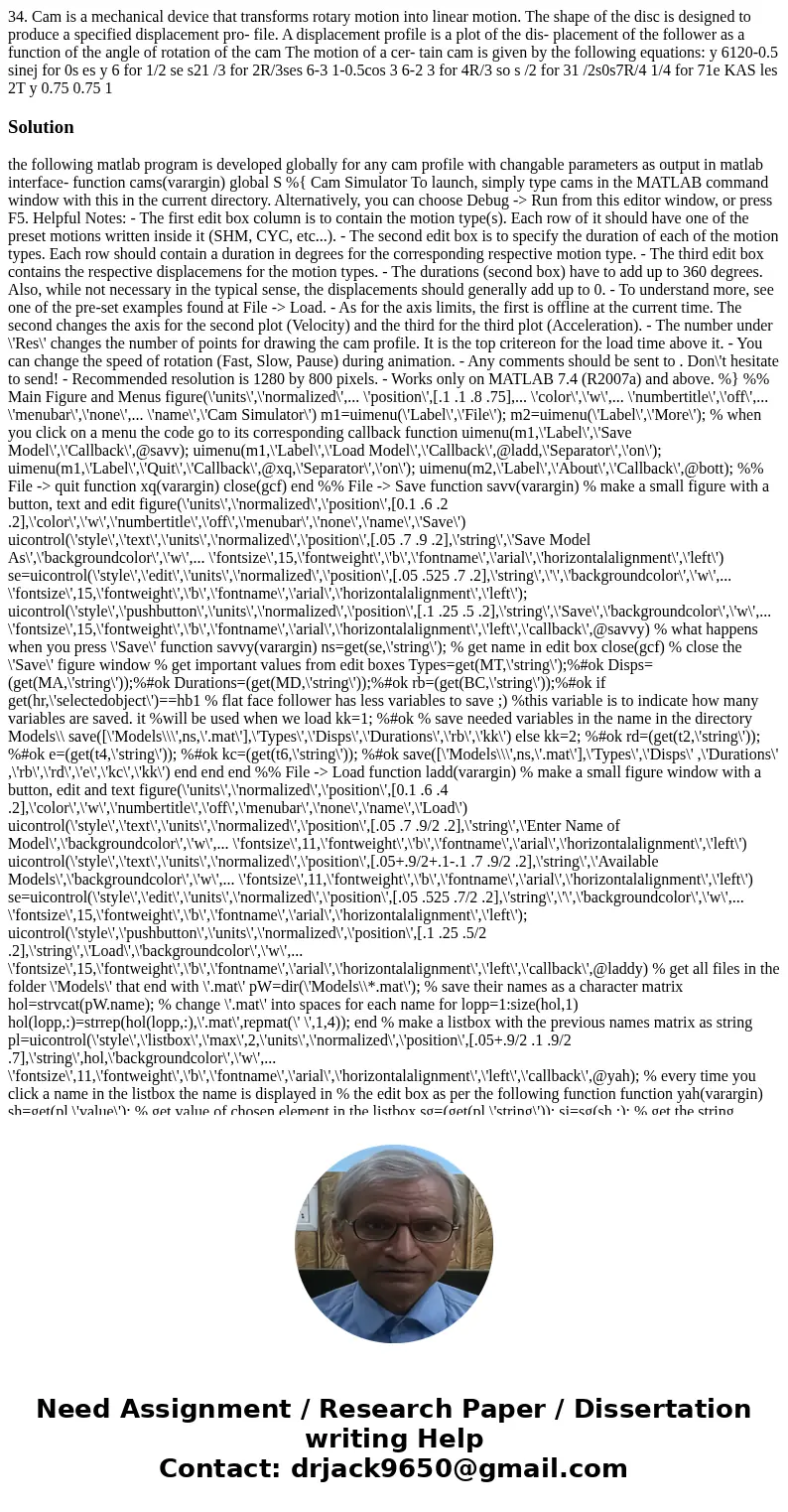
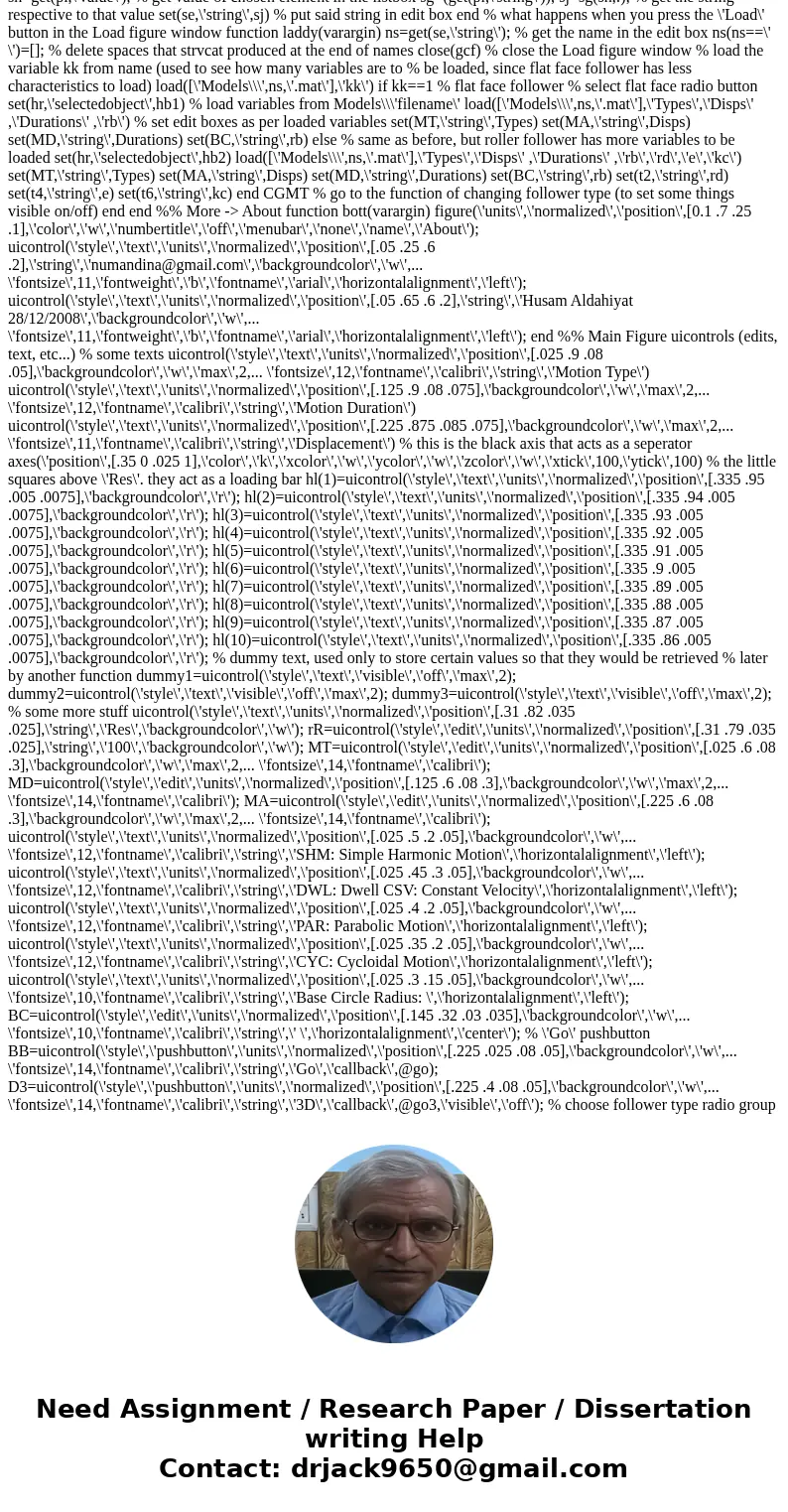
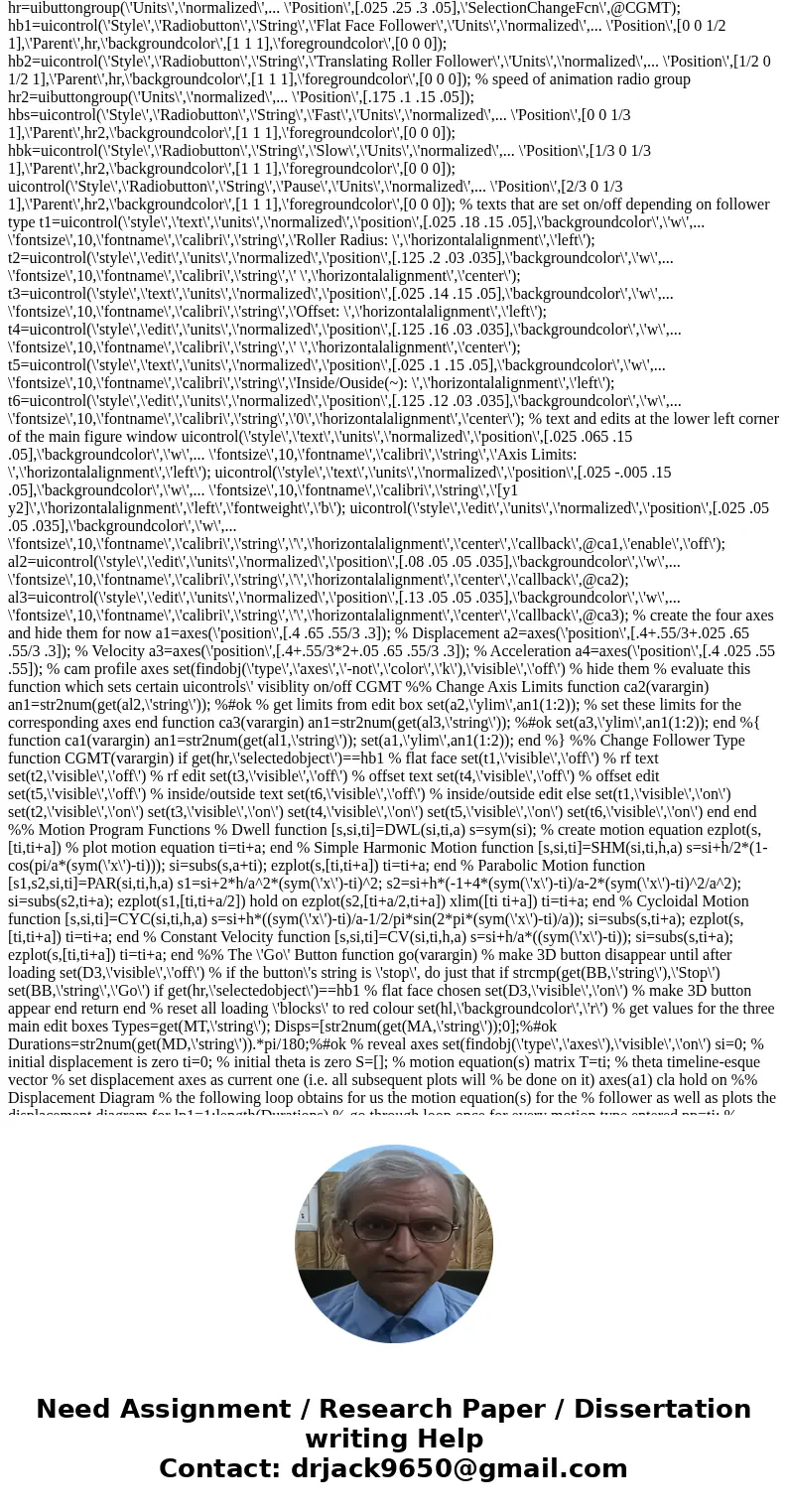
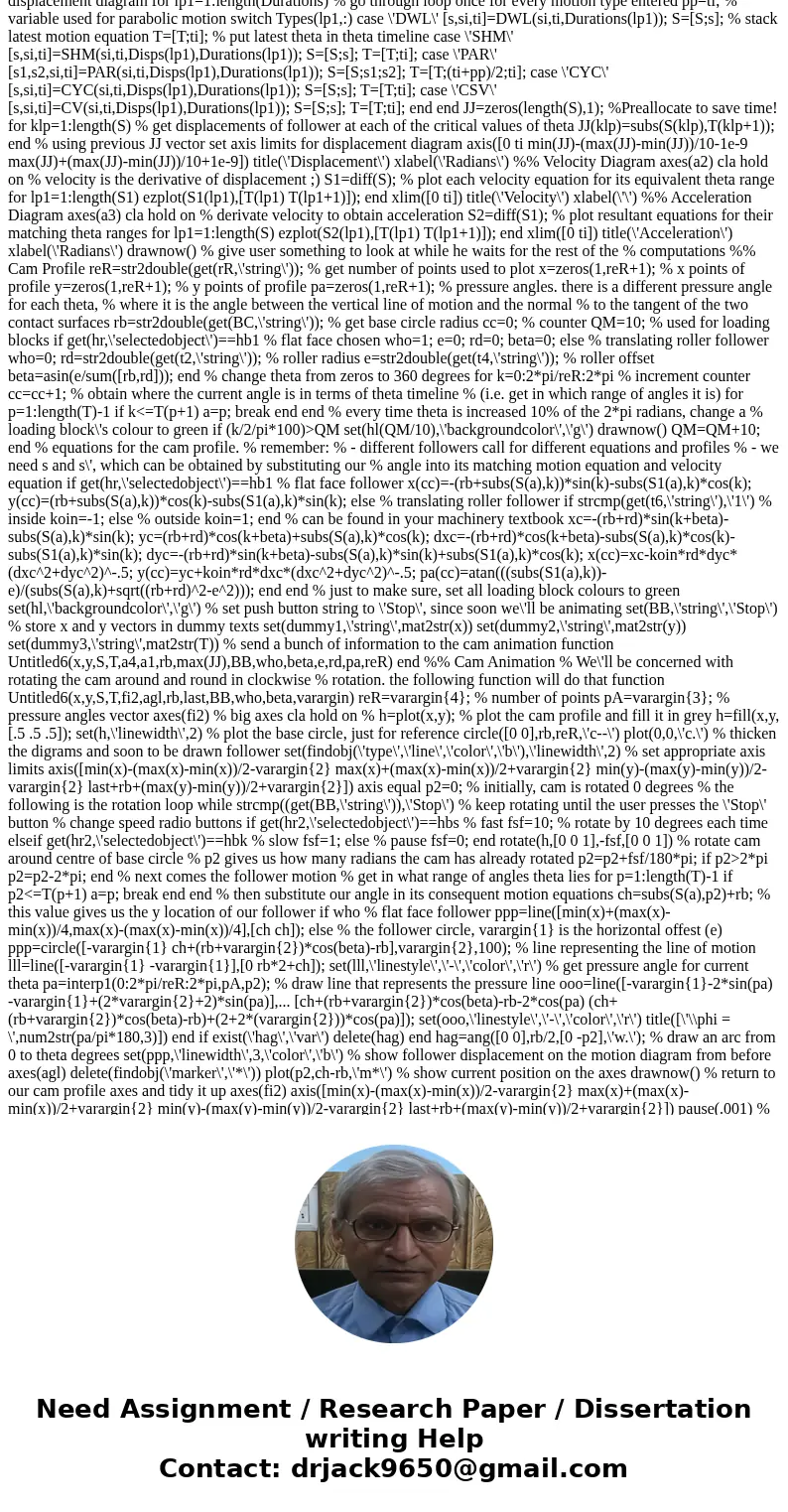
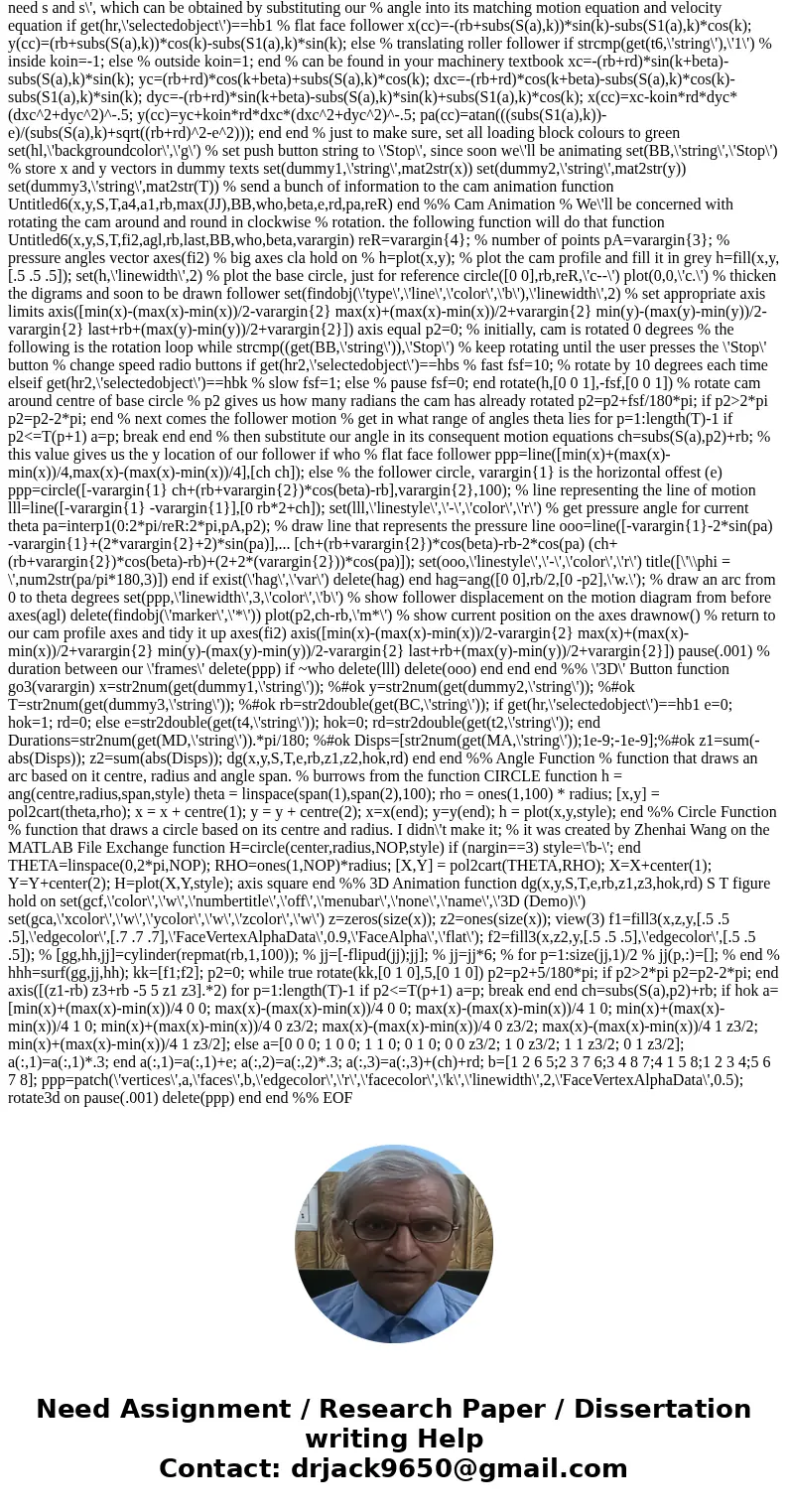
Solution
the following matlab program is developed globally for any cam profile with changable parameters as output in matlab interface- function cams(varargin) global S %{ Cam Simulator To launch, simply type cams in the MATLAB command window with this in the current directory. Alternatively, you can choose Debug -> Run from this editor window, or press F5. Helpful Notes: - The first edit box column is to contain the motion type(s). Each row of it should have one of the preset motions written inside it (SHM, CYC, etc...). - The second edit box is to specify the duration of each of the motion types. Each row should contain a duration in degrees for the corresponding respective motion type. - The third edit box contains the respective displacemens for the motion types. - The durations (second box) have to add up to 360 degrees. Also, while not necessary in the typical sense, the displacements should generally add up to 0. - To understand more, see one of the pre-set examples found at File -> Load. - As for the axis limits, the first is offline at the current time. The second changes the axis for the second plot (Velocity) and the third for the third plot (Acceleration). - The number under \'Res\' changes the number of points for drawing the cam profile. It is the top critereon for the load time above it. - You can change the speed of rotation (Fast, Slow, Pause) during animation. - Any comments should be sent to




 Homework Sourse
Homework Sourse